ENGL 301 Comparative Scene Paper: Violence in Film Analysis
VerifiedAdded on 2022/07/27
|6
|1610
|23
Report
AI Summary
This paper offers a comparative analysis of two films, Alfred Hitchcock's "Rear Window" (1954) and Clint Eastwood's "Unforgiven" (1992), focusing on how they utilize violence to elicit emotional responses from the audience. The paper argues that despite the greater presence of violence in "Unforgiven," Hitchcock's masterful use of techniques like lighting, close-up shots, and POV angles amplifies tension and anxiety in the audience, even within shorter sequences. The analysis delves into specific scenes, highlighting how Eastwood subverts the conventional Western genre to portray the horrors of violence, blurring the lines between hero and villain. The paper then examines Hitchcock's use of POV shots and close-ups in "Rear Window" to immerse the audience in the protagonist's perspective, manipulating their emotional response. The conclusion emphasizes that in both films, violence serves as a tool to explore characters' emotions rather than being the central focus, showcasing how film techniques shape the narrative and audience experience.
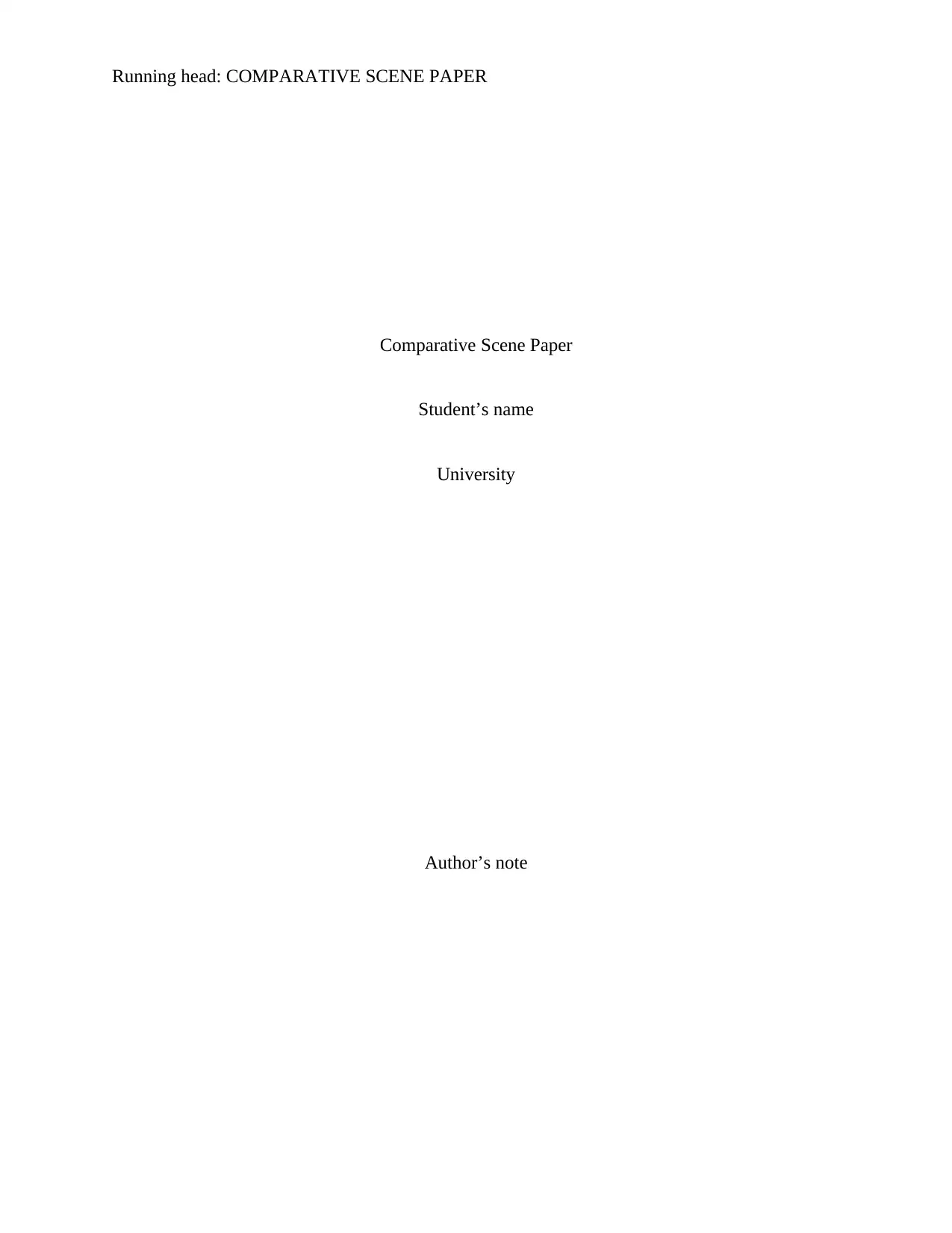
Running head: COMPARATIVE SCENE PAPER
Comparative Scene Paper
Student’s name
University
Author’s note
Comparative Scene Paper
Student’s name
University
Author’s note
Paraphrase This Document
Need a fresh take? Get an instant paraphrase of this document with our AI Paraphraser
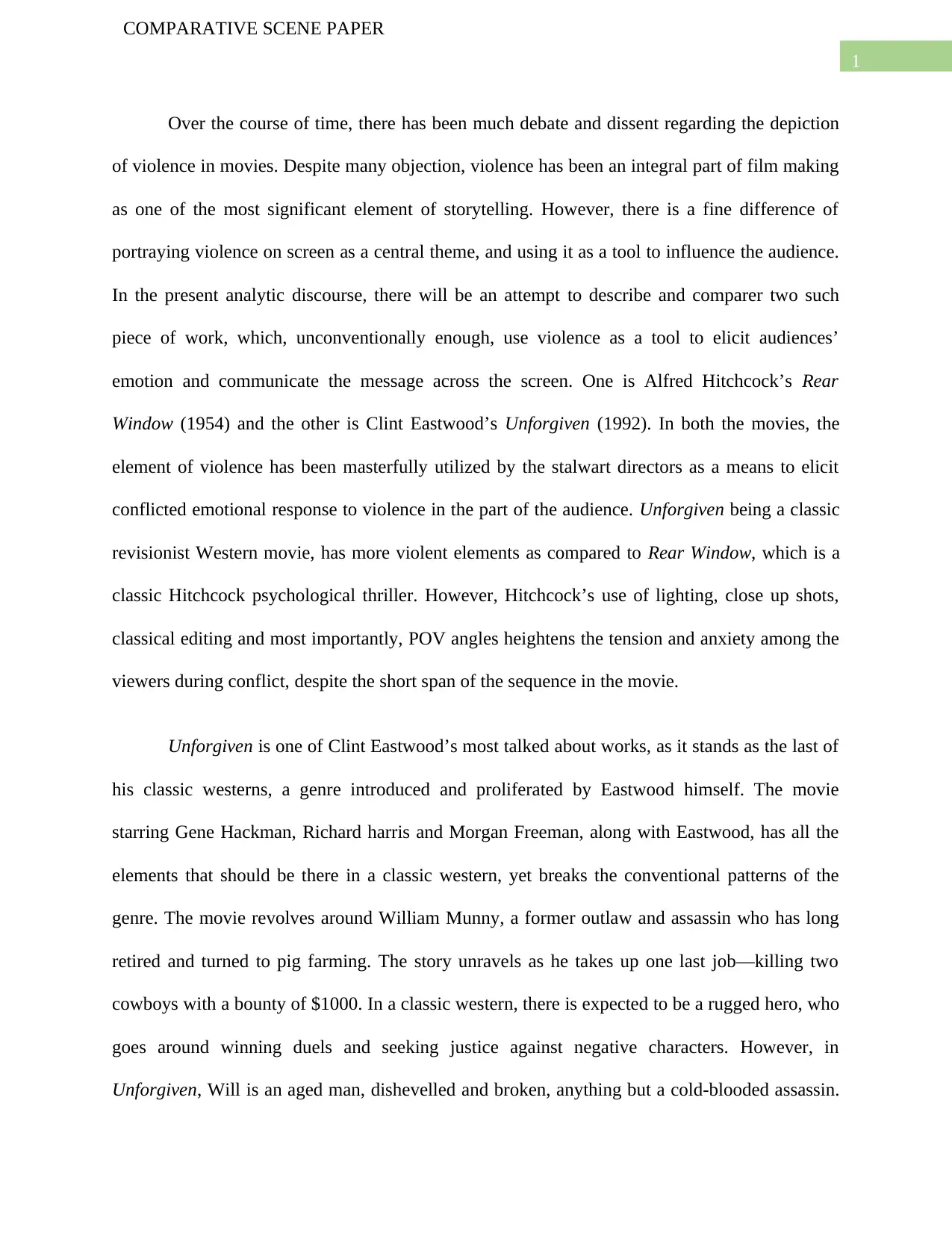
1
COMPARATIVE SCENE PAPER
Over the course of time, there has been much debate and dissent regarding the depiction
of violence in movies. Despite many objection, violence has been an integral part of film making
as one of the most significant element of storytelling. However, there is a fine difference of
portraying violence on screen as a central theme, and using it as a tool to influence the audience.
In the present analytic discourse, there will be an attempt to describe and comparer two such
piece of work, which, unconventionally enough, use violence as a tool to elicit audiences’
emotion and communicate the message across the screen. One is Alfred Hitchcock’s Rear
Window (1954) and the other is Clint Eastwood’s Unforgiven (1992). In both the movies, the
element of violence has been masterfully utilized by the stalwart directors as a means to elicit
conflicted emotional response to violence in the part of the audience. Unforgiven being a classic
revisionist Western movie, has more violent elements as compared to Rear Window, which is a
classic Hitchcock psychological thriller. However, Hitchcock’s use of lighting, close up shots,
classical editing and most importantly, POV angles heightens the tension and anxiety among the
viewers during conflict, despite the short span of the sequence in the movie.
Unforgiven is one of Clint Eastwood’s most talked about works, as it stands as the last of
his classic westerns, a genre introduced and proliferated by Eastwood himself. The movie
starring Gene Hackman, Richard harris and Morgan Freeman, along with Eastwood, has all the
elements that should be there in a classic western, yet breaks the conventional patterns of the
genre. The movie revolves around William Munny, a former outlaw and assassin who has long
retired and turned to pig farming. The story unravels as he takes up one last job—killing two
cowboys with a bounty of $1000. In a classic western, there is expected to be a rugged hero, who
goes around winning duels and seeking justice against negative characters. However, in
Unforgiven, Will is an aged man, dishevelled and broken, anything but a cold-blooded assassin.
COMPARATIVE SCENE PAPER
Over the course of time, there has been much debate and dissent regarding the depiction
of violence in movies. Despite many objection, violence has been an integral part of film making
as one of the most significant element of storytelling. However, there is a fine difference of
portraying violence on screen as a central theme, and using it as a tool to influence the audience.
In the present analytic discourse, there will be an attempt to describe and comparer two such
piece of work, which, unconventionally enough, use violence as a tool to elicit audiences’
emotion and communicate the message across the screen. One is Alfred Hitchcock’s Rear
Window (1954) and the other is Clint Eastwood’s Unforgiven (1992). In both the movies, the
element of violence has been masterfully utilized by the stalwart directors as a means to elicit
conflicted emotional response to violence in the part of the audience. Unforgiven being a classic
revisionist Western movie, has more violent elements as compared to Rear Window, which is a
classic Hitchcock psychological thriller. However, Hitchcock’s use of lighting, close up shots,
classical editing and most importantly, POV angles heightens the tension and anxiety among the
viewers during conflict, despite the short span of the sequence in the movie.
Unforgiven is one of Clint Eastwood’s most talked about works, as it stands as the last of
his classic westerns, a genre introduced and proliferated by Eastwood himself. The movie
starring Gene Hackman, Richard harris and Morgan Freeman, along with Eastwood, has all the
elements that should be there in a classic western, yet breaks the conventional patterns of the
genre. The movie revolves around William Munny, a former outlaw and assassin who has long
retired and turned to pig farming. The story unravels as he takes up one last job—killing two
cowboys with a bounty of $1000. In a classic western, there is expected to be a rugged hero, who
goes around winning duels and seeking justice against negative characters. However, in
Unforgiven, Will is an aged man, dishevelled and broken, anything but a cold-blooded assassin.
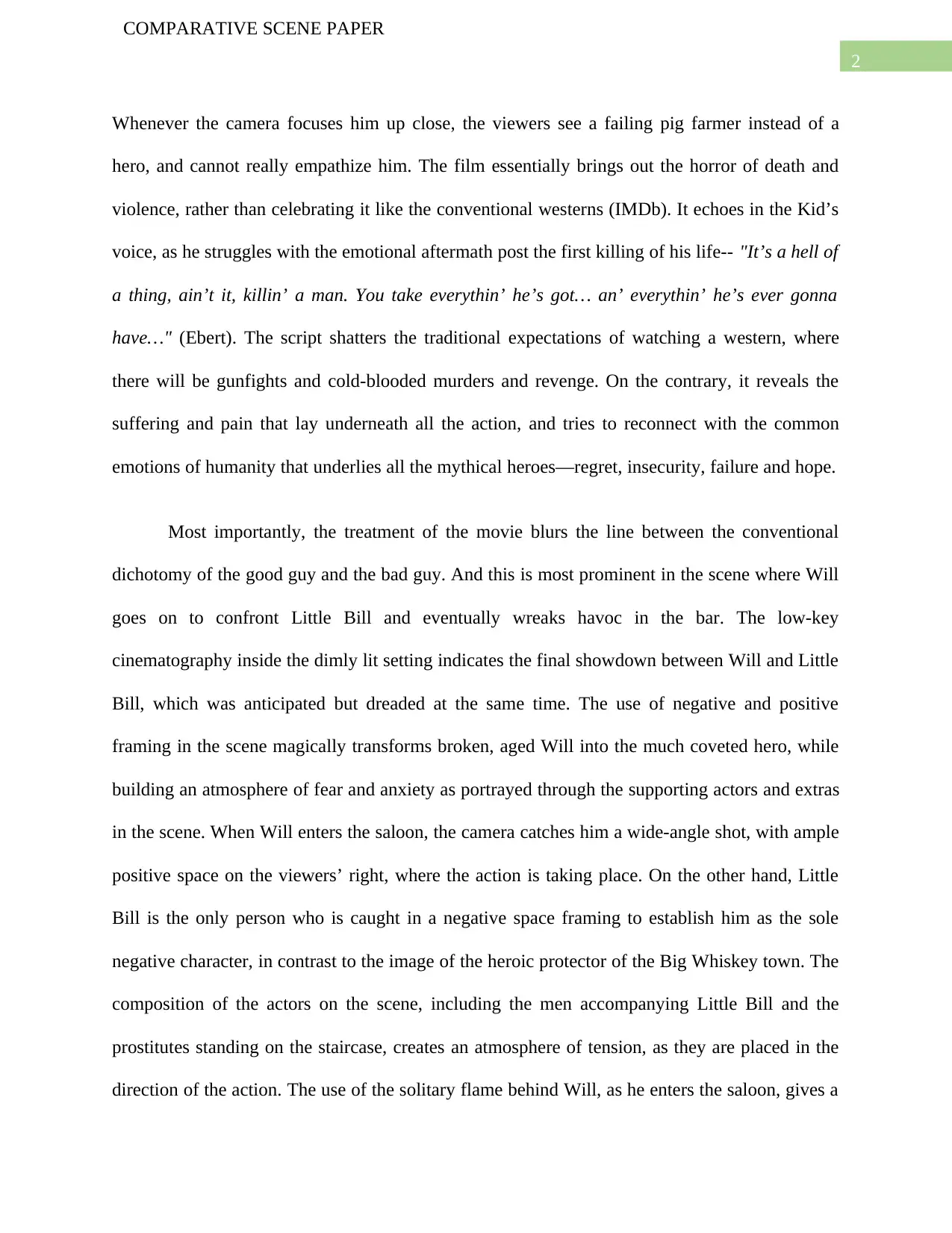
2
COMPARATIVE SCENE PAPER
Whenever the camera focuses him up close, the viewers see a failing pig farmer instead of a
hero, and cannot really empathize him. The film essentially brings out the horror of death and
violence, rather than celebrating it like the conventional westerns (IMDb). It echoes in the Kid’s
voice, as he struggles with the emotional aftermath post the first killing of his life-- "It’s a hell of
a thing, ain’t it, killin’ a man. You take everythin’ he’s got… an’ everythin’ he’s ever gonna
have…" (Ebert). The script shatters the traditional expectations of watching a western, where
there will be gunfights and cold-blooded murders and revenge. On the contrary, it reveals the
suffering and pain that lay underneath all the action, and tries to reconnect with the common
emotions of humanity that underlies all the mythical heroes—regret, insecurity, failure and hope.
Most importantly, the treatment of the movie blurs the line between the conventional
dichotomy of the good guy and the bad guy. And this is most prominent in the scene where Will
goes on to confront Little Bill and eventually wreaks havoc in the bar. The low-key
cinematography inside the dimly lit setting indicates the final showdown between Will and Little
Bill, which was anticipated but dreaded at the same time. The use of negative and positive
framing in the scene magically transforms broken, aged Will into the much coveted hero, while
building an atmosphere of fear and anxiety as portrayed through the supporting actors and extras
in the scene. When Will enters the saloon, the camera catches him a wide-angle shot, with ample
positive space on the viewers’ right, where the action is taking place. On the other hand, Little
Bill is the only person who is caught in a negative space framing to establish him as the sole
negative character, in contrast to the image of the heroic protector of the Big Whiskey town. The
composition of the actors on the scene, including the men accompanying Little Bill and the
prostitutes standing on the staircase, creates an atmosphere of tension, as they are placed in the
direction of the action. The use of the solitary flame behind Will, as he enters the saloon, gives a
COMPARATIVE SCENE PAPER
Whenever the camera focuses him up close, the viewers see a failing pig farmer instead of a
hero, and cannot really empathize him. The film essentially brings out the horror of death and
violence, rather than celebrating it like the conventional westerns (IMDb). It echoes in the Kid’s
voice, as he struggles with the emotional aftermath post the first killing of his life-- "It’s a hell of
a thing, ain’t it, killin’ a man. You take everythin’ he’s got… an’ everythin’ he’s ever gonna
have…" (Ebert). The script shatters the traditional expectations of watching a western, where
there will be gunfights and cold-blooded murders and revenge. On the contrary, it reveals the
suffering and pain that lay underneath all the action, and tries to reconnect with the common
emotions of humanity that underlies all the mythical heroes—regret, insecurity, failure and hope.
Most importantly, the treatment of the movie blurs the line between the conventional
dichotomy of the good guy and the bad guy. And this is most prominent in the scene where Will
goes on to confront Little Bill and eventually wreaks havoc in the bar. The low-key
cinematography inside the dimly lit setting indicates the final showdown between Will and Little
Bill, which was anticipated but dreaded at the same time. The use of negative and positive
framing in the scene magically transforms broken, aged Will into the much coveted hero, while
building an atmosphere of fear and anxiety as portrayed through the supporting actors and extras
in the scene. When Will enters the saloon, the camera catches him a wide-angle shot, with ample
positive space on the viewers’ right, where the action is taking place. On the other hand, Little
Bill is the only person who is caught in a negative space framing to establish him as the sole
negative character, in contrast to the image of the heroic protector of the Big Whiskey town. The
composition of the actors on the scene, including the men accompanying Little Bill and the
prostitutes standing on the staircase, creates an atmosphere of tension, as they are placed in the
direction of the action. The use of the solitary flame behind Will, as he enters the saloon, gives a
⊘ This is a preview!⊘
Do you want full access?
Subscribe today to unlock all pages.

Trusted by 1+ million students worldwide
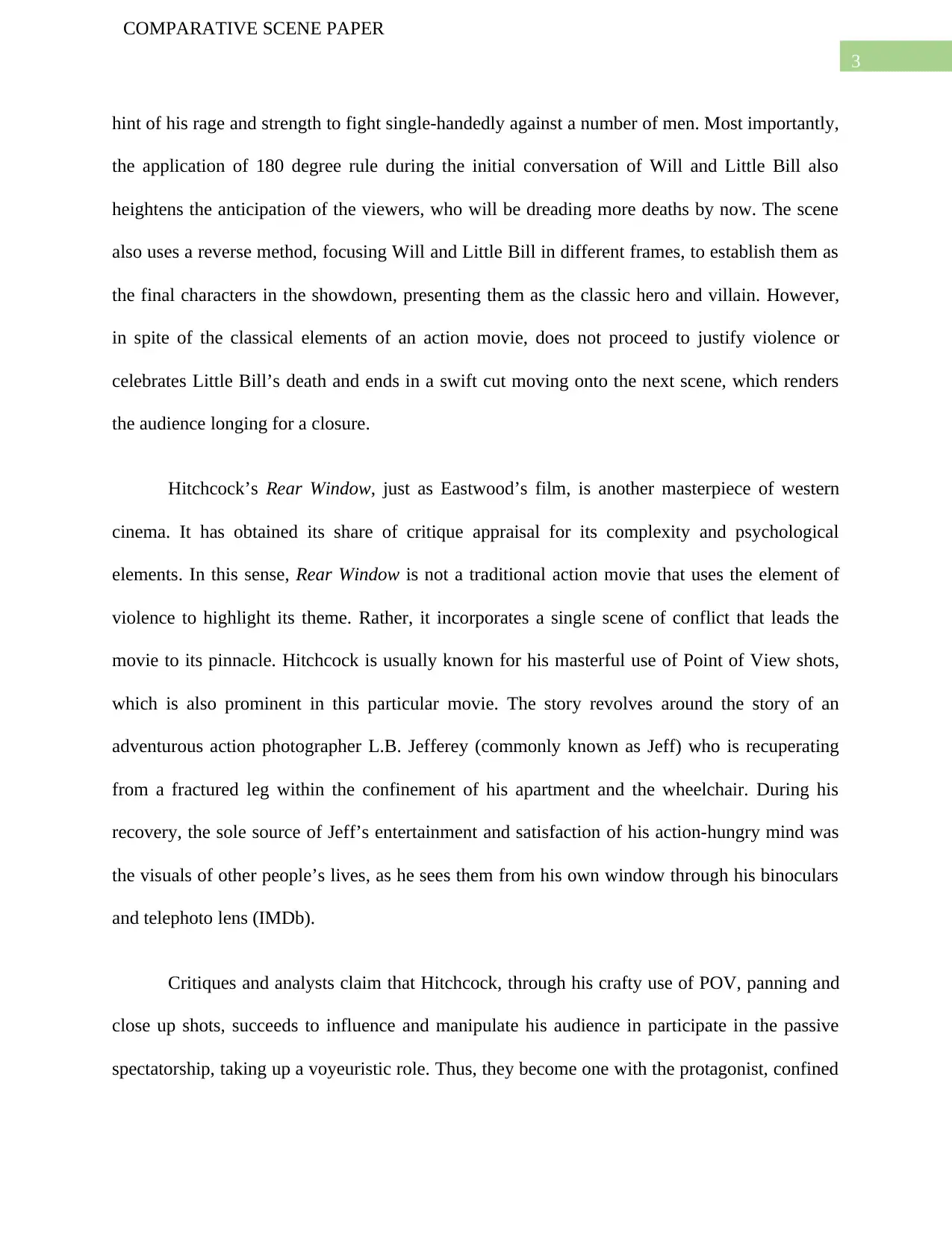
3
COMPARATIVE SCENE PAPER
hint of his rage and strength to fight single-handedly against a number of men. Most importantly,
the application of 180 degree rule during the initial conversation of Will and Little Bill also
heightens the anticipation of the viewers, who will be dreading more deaths by now. The scene
also uses a reverse method, focusing Will and Little Bill in different frames, to establish them as
the final characters in the showdown, presenting them as the classic hero and villain. However,
in spite of the classical elements of an action movie, does not proceed to justify violence or
celebrates Little Bill’s death and ends in a swift cut moving onto the next scene, which renders
the audience longing for a closure.
Hitchcock’s Rear Window, just as Eastwood’s film, is another masterpiece of western
cinema. It has obtained its share of critique appraisal for its complexity and psychological
elements. In this sense, Rear Window is not a traditional action movie that uses the element of
violence to highlight its theme. Rather, it incorporates a single scene of conflict that leads the
movie to its pinnacle. Hitchcock is usually known for his masterful use of Point of View shots,
which is also prominent in this particular movie. The story revolves around the story of an
adventurous action photographer L.B. Jefferey (commonly known as Jeff) who is recuperating
from a fractured leg within the confinement of his apartment and the wheelchair. During his
recovery, the sole source of Jeff’s entertainment and satisfaction of his action-hungry mind was
the visuals of other people’s lives, as he sees them from his own window through his binoculars
and telephoto lens (IMDb).
Critiques and analysts claim that Hitchcock, through his crafty use of POV, panning and
close up shots, succeeds to influence and manipulate his audience in participate in the passive
spectatorship, taking up a voyeuristic role. Thus, they become one with the protagonist, confined
COMPARATIVE SCENE PAPER
hint of his rage and strength to fight single-handedly against a number of men. Most importantly,
the application of 180 degree rule during the initial conversation of Will and Little Bill also
heightens the anticipation of the viewers, who will be dreading more deaths by now. The scene
also uses a reverse method, focusing Will and Little Bill in different frames, to establish them as
the final characters in the showdown, presenting them as the classic hero and villain. However,
in spite of the classical elements of an action movie, does not proceed to justify violence or
celebrates Little Bill’s death and ends in a swift cut moving onto the next scene, which renders
the audience longing for a closure.
Hitchcock’s Rear Window, just as Eastwood’s film, is another masterpiece of western
cinema. It has obtained its share of critique appraisal for its complexity and psychological
elements. In this sense, Rear Window is not a traditional action movie that uses the element of
violence to highlight its theme. Rather, it incorporates a single scene of conflict that leads the
movie to its pinnacle. Hitchcock is usually known for his masterful use of Point of View shots,
which is also prominent in this particular movie. The story revolves around the story of an
adventurous action photographer L.B. Jefferey (commonly known as Jeff) who is recuperating
from a fractured leg within the confinement of his apartment and the wheelchair. During his
recovery, the sole source of Jeff’s entertainment and satisfaction of his action-hungry mind was
the visuals of other people’s lives, as he sees them from his own window through his binoculars
and telephoto lens (IMDb).
Critiques and analysts claim that Hitchcock, through his crafty use of POV, panning and
close up shots, succeeds to influence and manipulate his audience in participate in the passive
spectatorship, taking up a voyeuristic role. Thus, they become one with the protagonist, confined
Paraphrase This Document
Need a fresh take? Get an instant paraphrase of this document with our AI Paraphraser
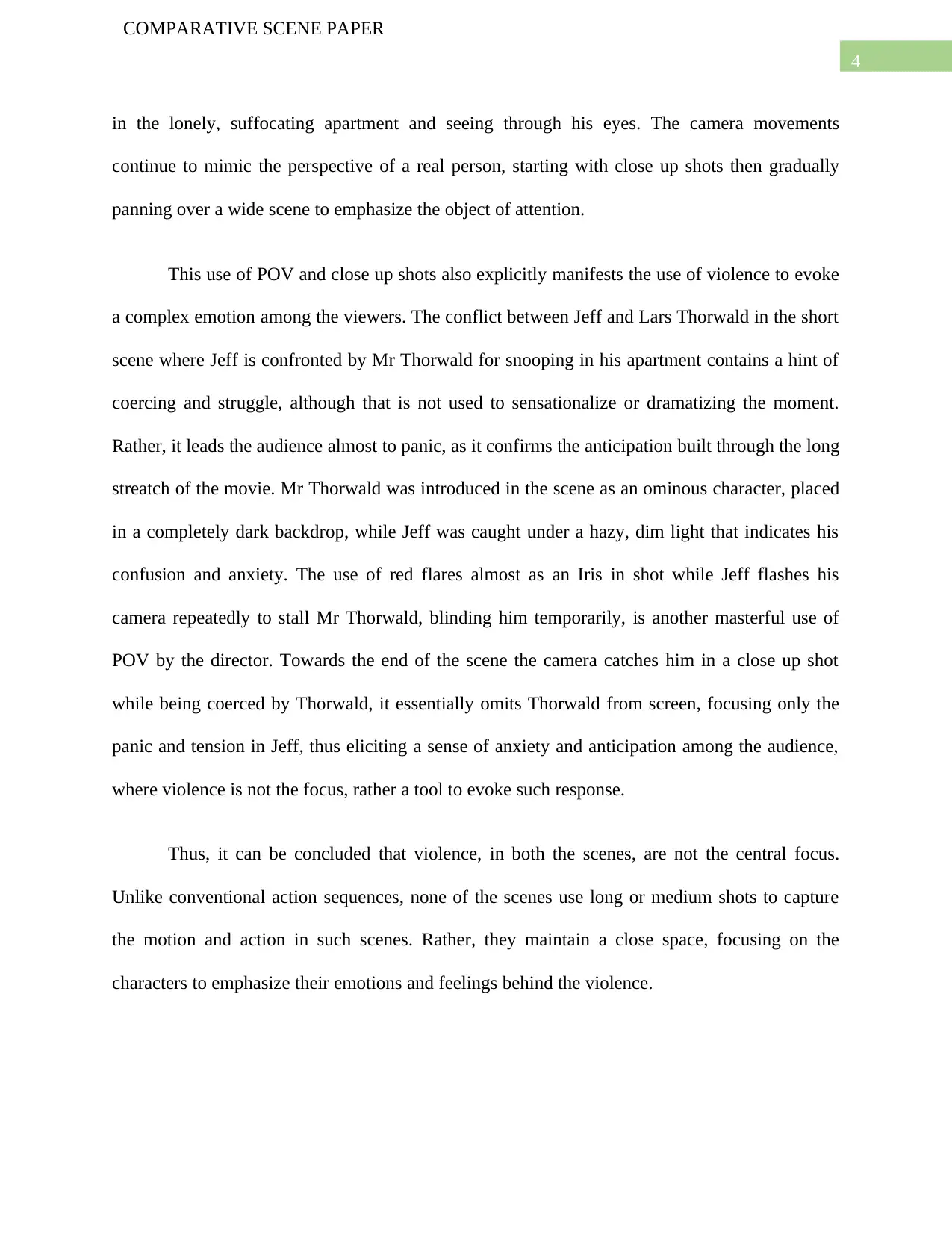
4
COMPARATIVE SCENE PAPER
in the lonely, suffocating apartment and seeing through his eyes. The camera movements
continue to mimic the perspective of a real person, starting with close up shots then gradually
panning over a wide scene to emphasize the object of attention.
This use of POV and close up shots also explicitly manifests the use of violence to evoke
a complex emotion among the viewers. The conflict between Jeff and Lars Thorwald in the short
scene where Jeff is confronted by Mr Thorwald for snooping in his apartment contains a hint of
coercing and struggle, although that is not used to sensationalize or dramatizing the moment.
Rather, it leads the audience almost to panic, as it confirms the anticipation built through the long
streatch of the movie. Mr Thorwald was introduced in the scene as an ominous character, placed
in a completely dark backdrop, while Jeff was caught under a hazy, dim light that indicates his
confusion and anxiety. The use of red flares almost as an Iris in shot while Jeff flashes his
camera repeatedly to stall Mr Thorwald, blinding him temporarily, is another masterful use of
POV by the director. Towards the end of the scene the camera catches him in a close up shot
while being coerced by Thorwald, it essentially omits Thorwald from screen, focusing only the
panic and tension in Jeff, thus eliciting a sense of anxiety and anticipation among the audience,
where violence is not the focus, rather a tool to evoke such response.
Thus, it can be concluded that violence, in both the scenes, are not the central focus.
Unlike conventional action sequences, none of the scenes use long or medium shots to capture
the motion and action in such scenes. Rather, they maintain a close space, focusing on the
characters to emphasize their emotions and feelings behind the violence.
COMPARATIVE SCENE PAPER
in the lonely, suffocating apartment and seeing through his eyes. The camera movements
continue to mimic the perspective of a real person, starting with close up shots then gradually
panning over a wide scene to emphasize the object of attention.
This use of POV and close up shots also explicitly manifests the use of violence to evoke
a complex emotion among the viewers. The conflict between Jeff and Lars Thorwald in the short
scene where Jeff is confronted by Mr Thorwald for snooping in his apartment contains a hint of
coercing and struggle, although that is not used to sensationalize or dramatizing the moment.
Rather, it leads the audience almost to panic, as it confirms the anticipation built through the long
streatch of the movie. Mr Thorwald was introduced in the scene as an ominous character, placed
in a completely dark backdrop, while Jeff was caught under a hazy, dim light that indicates his
confusion and anxiety. The use of red flares almost as an Iris in shot while Jeff flashes his
camera repeatedly to stall Mr Thorwald, blinding him temporarily, is another masterful use of
POV by the director. Towards the end of the scene the camera catches him in a close up shot
while being coerced by Thorwald, it essentially omits Thorwald from screen, focusing only the
panic and tension in Jeff, thus eliciting a sense of anxiety and anticipation among the audience,
where violence is not the focus, rather a tool to evoke such response.
Thus, it can be concluded that violence, in both the scenes, are not the central focus.
Unlike conventional action sequences, none of the scenes use long or medium shots to capture
the motion and action in such scenes. Rather, they maintain a close space, focusing on the
characters to emphasize their emotions and feelings behind the violence.
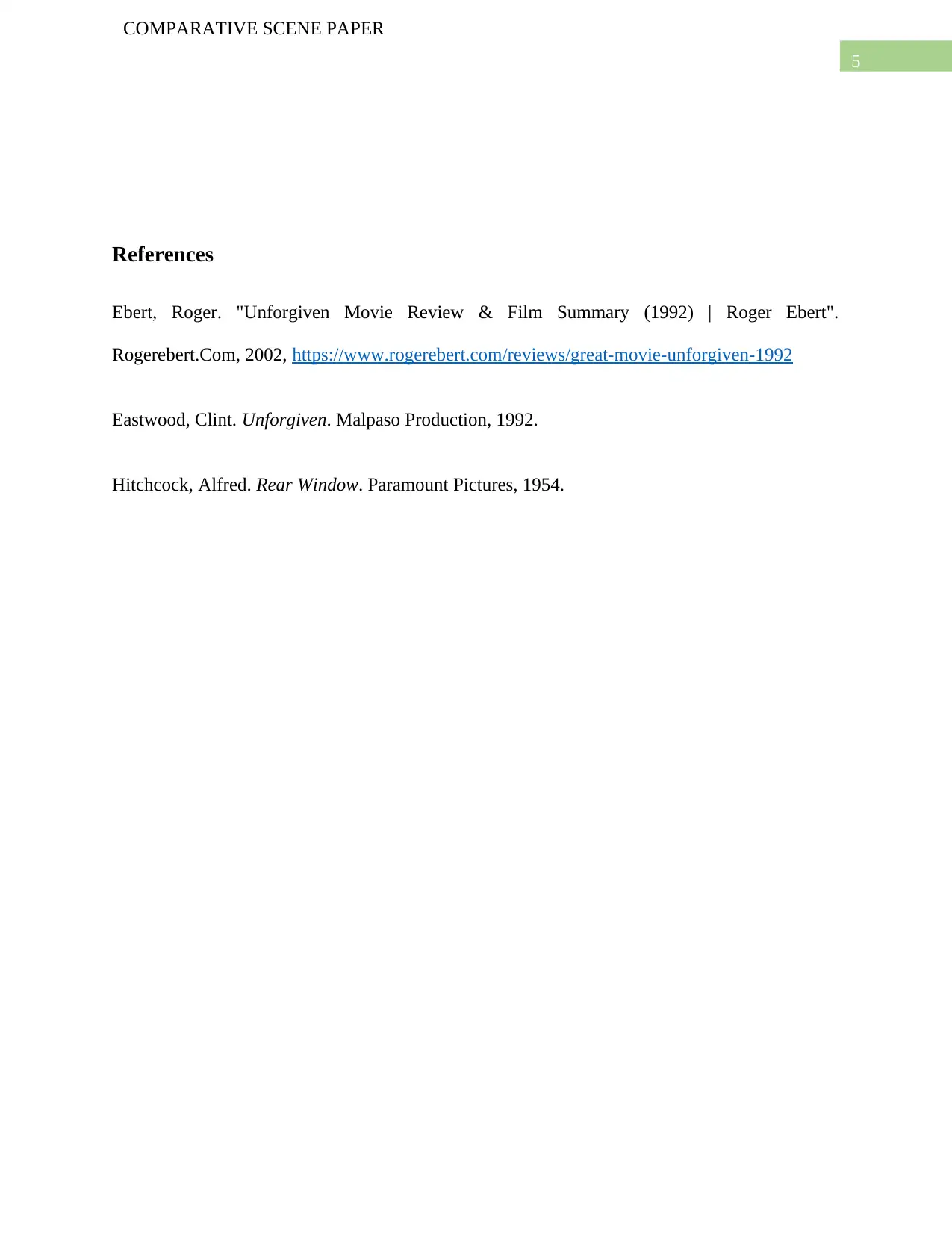
5
COMPARATIVE SCENE PAPER
References
Ebert, Roger. "Unforgiven Movie Review & Film Summary (1992) | Roger Ebert".
Rogerebert.Com, 2002, https://www.rogerebert.com/reviews/great-movie-unforgiven-1992
Eastwood, Clint. Unforgiven. Malpaso Production, 1992.
Hitchcock, Alfred. Rear Window. Paramount Pictures, 1954.
COMPARATIVE SCENE PAPER
References
Ebert, Roger. "Unforgiven Movie Review & Film Summary (1992) | Roger Ebert".
Rogerebert.Com, 2002, https://www.rogerebert.com/reviews/great-movie-unforgiven-1992
Eastwood, Clint. Unforgiven. Malpaso Production, 1992.
Hitchcock, Alfred. Rear Window. Paramount Pictures, 1954.
⊘ This is a preview!⊘
Do you want full access?
Subscribe today to unlock all pages.

Trusted by 1+ million students worldwide
1 out of 6
Your All-in-One AI-Powered Toolkit for Academic Success.
+13062052269
info@desklib.com
Available 24*7 on WhatsApp / Email
![[object Object]](/_next/static/media/star-bottom.7253800d.svg)
Unlock your academic potential
Copyright © 2020–2025 A2Z Services. All Rights Reserved. Developed and managed by ZUCOL.
